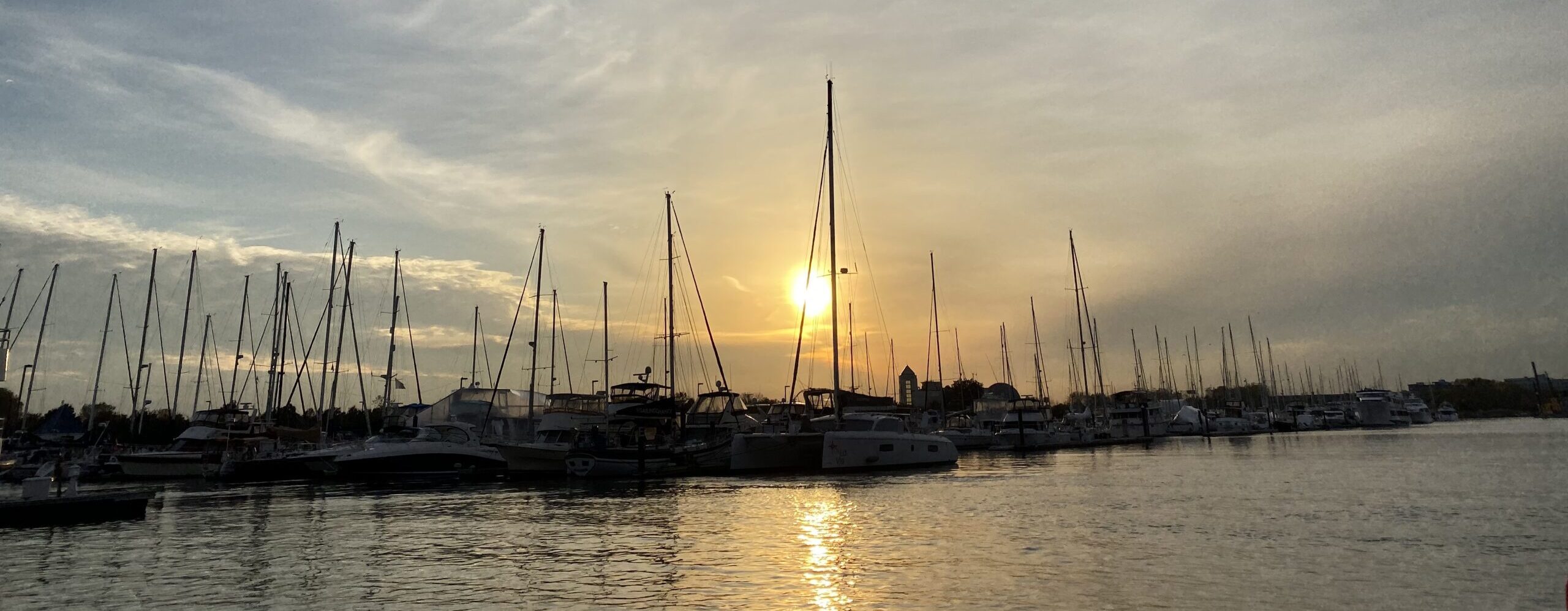A citrus sunset in the west, a glass of wine or a cup of tea in your hand, and a bowl of snacks to go around mark the end of another day adventuring with your loved ones on your boat. After the encroaching dark blue sky finally kisses the water at the horizon, you retire below, where the lull of the waves gently rocks you to sleep. The joys of cruising and adventuring on the water can also beget peace and relaxation if you plan accordingly--which is exactly what this article is designed to help you achieve.
Navigation: The Journey and the Destination
First, you need to decide where you want to go on your voyage and how you will get there. Once you have an idea of the area you’ll be traversing, we highly recommend procuring paper charts of the area. Even vessels equipped with the most up-to-date GPS and chartplotter need paper charts onboard to aid the skipper in the event of dead batteries or any emergency. Paper charts ensure that you can arrive safely at your destination should electronics fail--just make sure to brush up on your navigational and chartplotting skills by watching YouTube videos or reading.
Navigation Packing List:
- An accurate and working compass
- Parallel rulers
- Divider
- Pencils
- Paper charts
Weather or outside forces may compel you to change your route or extend your trip. Remain flexible and patient and identify alternative routes, destinations, and safe harbors should the need arise.
Fuel
Even if this is your first overnight voyage, it’s probably not your first time using your vessel--you should already have some idea of your boat’s fuel consumption. Calculate how far you expect to travel roundtrip and how much fuel you will need to complete the trip. This information will help you predict how many times and thus where along your route you need to refuel. However, best practice is to identify the location of all fuel docks along your route should the need arise.
We highly recommend carrying ample backup jerrycans. You may pull up to a fuel dock hoping to restock, only to discover they’re out of fuel for the day. Carrying jerrycans of fuel will alleviate inconveniences like this, ensuring that you can make it to the next fuel dock safely. Just remember to refill them after you use them!
According to North Carolina Sea Grant, you can ascertain average fuel usage at gallons per hour (gph) at full throttle by dividing horsepower by 10. They provide this example in their article “ON THE WATER: Save Fuel, Money: Running Your Boat by the Numbers”:
“A boater with a four-stroke, 250-hp marine outboard engine running at full throttle, or about 6,100 rpm, is using 25 gph. But, an engine is most efficient at 75 to 80 percent of rated output rather than at full throttle. The same boater reports that throttling back to 77.5 percent of rated output, or 4,728 rpm, consumes only 12.5 gph, for a 50 percent fuel savings.”
In boating, the adventure and fun is in the journey and the destination. Dialing it back on the throttle may lengthen the journey, but it will also extend the life of your fuel reserves--resulting in more fun on the water and less time spent at the dock refueling.
Water: Anticipating Consumption and Encouraging Conservation
You need to keep an eye on your water consumption like never before. You use water to bathe, drink, cook, clean, brush your teeth, and more. How much water storage do you have onboard and how long do you expect it to last with all your guests? This section will help you answer that question. Some boaters opt for additional water storage through 5-gallon jugs or even water bladders, which come in various sizes and resemble air mattresses.
No matter how large your water reserves are, you need to strategize about how and where you will refill them. For efficiency and convenience, where you refill should coincide with where you refuel (more on that later). However, be sure to keep a garden hose onboard in case you end up refilling somewhere with only a spigot available.
We highly recommend your boat is outfitted with a manual freshwater/saltwater pump, which brings water from outside the boat that can be used to rinse dishes, flush the toilet, and more--all without using your precious battery charge.
Here are some questions to get you thinking about water and planning your water reserves:
- How many water tanks do I have onboard? What is the overall water capacity?
- Are all faucets and pumps working properly? Make sure to test everything while disconnected from shore power before leaving the dock.
- 1-gallon jugs, 2-liter jugs, 5-gallon jugs, and water bladders: where can I store them while underway?
- How many people are coming aboard? Budget at least one gallon/day/person for drinking and 5-10 gallons/day/person for bathing when factoring in water consumption. Don’t forget to anticipate cooking and cleaning needs as well, which vary depending on each cruiser.
- How will you discuss water consumption and conservation with your passengers and crew? Raise awareness and encourage them to cut their showers short, or even shower with sea water then rinse off with fresh water.
- Where and when do you plan on refilling your tanks? You never want to run empty, so best practice is to fill up the day before you anticipate an empty tank--especially since you may consume more water than anticipated.
Provisioning: Eating and Cooking in the Galley
The golden rule to stocking your galley is simple: if you want to eat it, you have to bring it. Depending on the type of voyage you plan, you may not have easy access to a grocery store or market. Best practice is to chat with your crew/passengers and take suggestions for snacks, drinks, and meals in advance.
Some people avoid cooking and opt to eat sandwiches and instant foods like ramen noodles while voyaging. Cooking underway can be dangerous and should be done with extreme caution (if attempted), but there will be many opportunities to enjoy a hot meal on deck with your fellow voyagers while anchored or moored. Remember to take advantage of outside cooking equipment when possible, since cooking below deck may make it hot and uncomfortable later. Read more about cooking on board in our guide: Safety Guidelines for Cooking and Heating on your Boat.
Don’t object if your crew or passengers want an easy meal! Hot dogs and/or hamburgers are a great treat if you have a way to store the meat. Grits or oatmeal work great as breakfast foods and can be paired with fruit or even eggs (which don’t need to be refrigerated if bought fresh from a farmer’s market).
Dry foods are your dependable friend aboard--always keep rice and pasta in stock. Quinoa and couscous also keep well. You should also have a healthy reserve of cans, from fruits and veggies to tuna and chicken--all depends on your palate and that of your crew and passengers. Coconut milk, evaporated milk, and condensed milk are all canned dairy alternatives. Nuts and peanut butter are good sources of protein as long as there are no allergy problems.
And remember: eating seafood can be a delicious and exciting way to amplify your water excursion! Try catching and cooking to make your meal extra memorable. You’re not limited to fishing poles either--casting nets, crab traps, and dip nets are also helpful tools for successfully snagging seafood. Just don’t forget that fishing license! Review the laws in your state and any others you may be entering during your voyage.
When that craving for a homemade meal hits, here is a list of fresh produce that will store well in the galley without refrigeration. Pull some of your ingredients from it!
Produce that stores well without refrigeration:
- Potatoes
- Onions
- Garlic
- Limes/Lemons/Citrus fruits
- Squash
- Avocadoes
- Peppers
- Sweet potatoes
- Radishes
- Apples
- Bananas
- Melons
- Tomatoes (can store well but may mold after a few days)
Coexisting Aboard Peacefully
When traveling with family and friends, don’t shy away from dividing up boat responsibilities. Electing and assigning duties will ease pressure off the skipper and cultivate a team environment where all work together for the greater adventure. Some potential positions include: navigation assistant, galley prep/cook, and clean-up. Feel free to rotate responsibilities every 24-48 hours to avoid monotony.
Anticipating challenges and setting expectations will help to avoid future headaches on your adventure. Even a large boat is much smaller than any house, so keep a few things in mind:
- Where will guests store their personal belongings? Encourage them to bring only one collapsible bag for their belongings and a small backpack or pocketbook for shore excursions
- Where will guests store dirty laundry and hang wet items to dry?
- What are the standards of cleanliness for coexisting aboard? Remind guests that everything on a boat has its place! If you use something, return it to the same place.
The Yacht Club Advantage
If you are a member of a local yacht club, it would be advantageous to research other yacht clubs along your route and discover if you enjoy reciprocity benefits. Some yacht clubs offer free or discounted mooring and berth as well as access to yacht club facilities to members of partnering yacht clubs. A simple phone call or email could check various items off your checklist about refilling water, taking showers, and accessing shore.
Extra Protection is Always Best
Part of the fun of adventuring on the water involves exploring the unknown--which can sometimes have consequences. A smart skipper hopes for the best but prepares for the worst--and there’s no better way to cover yourself and your vessel than with Ahoy! Insurance. Getting boat insurance with Ahoy! will give you peace of mind knowing that we have your back when you need a tow, are involved in an accident, are affected by a storm, or even if your cell phone falls overboard. Your policy also comes with access to our state-of-the-art app, which has up-to-date NOAA charts and real-time information about wind speed and direction, wave direction, and current flow. The Safe Navigation feature will even vibrate and sound to alert you to any charted obstacles such as a shoal, underwater rocks, buoys, etc. So get a quote online today--it takes only minutes!
One last thing
Adventuring on a boat offers the opportunity to step into a more comfortable and relaxed pace of life, be it for an afternoon or a week. Much of our lives on land are focused on planning for and worrying about tomorrow, next week, or even next year--but as your boat leaves the dock, your land life melts away. Suddenly, you are focused on the present, observing the water as you make your way toward your destination. Watching the weather and natural environment awakens our senses to things we may overlook in our daily lives: the speed at which clouds roll across a cerulean sky, the direction of a water current, or the even exposed mud of the marshlands during low tide. Living these experiences alongside loved ones can strengthen relationships and create long-lasting memories--and now that you’ve read this article, you’re ready to plan your own trip, too. Safe, happy, and fulfilling adventures await!


